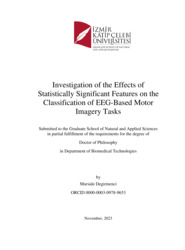Investigation of the Effects of Statistically Significant Features on the Classification of EEG-Based Motor Imagery Tasks
-
Eser Sahibi
Murside Degirmenci
- Tez Danışmanı Yalçın İşler
-
Tür
Doktora Tezi
- Yayın Tarihi 2024
-
Yayıncı
İzmir Katip Çelebi Üniversitesi Fen Bilimleri Enstitüsü
- Tek Biçim Adres https://hdl.handle.net/11469/3870
-
Konu Başlıkları
Extremity movement task classification
finger movement
EEG
Motor imagery (MI) task classification is highly prevalent in Electroencephalography
(EEG)-based Brain-Computer Interface (BCI) research area. Extremity movement task
classification and finger movement classification studies are presented in this thesis.
In extremity movement classification, binary-class (right hand and left hand) and
multi-class (right hand, left hand, right hand, and left hand) classifications are
performed using 4 different feature extraction approaches and statistically
significance-based feature selection (the independent t-test, one-way ANOVA test).
Firstly, time-domain, Fourier Transform (FT)-based frequency-domain, and Wavelet
Transform (WT)-based time-frequency domain features are calculated from multichannel EEG signals. In addition to these features, Poincare plot measures-based nonlinear features are calculated. Two different combination sets are also created to
classify MI tasks of EEG segments using the extracted features. For finger movement
classification, time-domain, frequency-domain, WT-based time-frequency domain,
non-linear and their two different combinations set features are investigated using
ANOVA-based and Pricipal Component Analysis (PCA)-based feature selection
methods. Intrincsic Time-Scale Decomposition (ITD)-based time-frequency features
are also investigated using ANOVA-based feature selection. 9 different machine
learning algorithms namely Decision Tree (DT), Support Vector Machine (SVM), kNearest Neighbor (k-NN), Naive Bayes (NB), Logistic Regression (LR), Discriminant
Analysis (DA), Neural Networks (NN), and Kernel Approximation (KA) are used
based on 5-fold cross-validation to distinguish different groups. According to
experimental results, the most successful feature sets are Poincare plot measures-based
non-linear feature set and the combination set of different feature sets in extremity and
finger movement classification studies. The statistically significance-based feature
selection method improved classification performance in most of the feature sets.
-
Koleksiyonlar
ENSTİTÜLER
FEN BİLİMLERİ ENSTİTÜSÜ

 Tam Metin
Tam Metin

